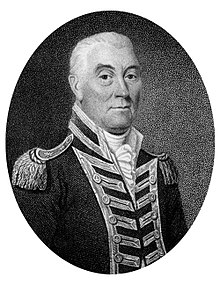John Holloway (Royal Navy officer)
John Holloway | |
|---|---|
 | |
| Born | 15 January 1744 Wells, Somerset |
| Died | 26 June 1826 (aged 82) Wells, Somerset |
| Allegiance | Great Britain United Kingdom |
| Service/ | Royal Navy |
| Years of service | 1760–1809 |
| Rank | Admiral |
| Commands held | |
| Battles/wars |
|
Admiral John Holloway (15 January 1744 – 26 June 1826) was an officer of the
Biography
Early career
Holloway was born in
American Revolutionary War
When the
On 23 January 1780, he was promoted to post-captain, and returned to the Vengeance, to serve as Commodore Hotham's flag captain, and was present at the Battle of Martinique in April. In September Hotham assumed command at the Leeward Islands. On the night of 10 October the British were moored at St. Lucia when a hurricane struck, lasting for 29 hours. Eight frigates and sloops were completely wrecked, and the rest of the fleet suffered considerable damage. Vengeance finally sailed for England in early 1781, with another ship and three frigates, as escort to a convoy of thirty-four richly-laden merchant ships, mainly Dutch, which had been captured at St. Eustatia in February. On 2 May they encountered a French squadron of six ships and three frigates, under the command of Picquet de la Motte. Hotham managed to preserve his own squadron, but the French captured twenty-six of the merchant ships, valued at 5 million pounds.[1]
Holloway was soon appointed to command of the 80-gun
On his return to England, Holloway was appointed to command of the 64-gun ship
French Revolutionary War
On the outbreak of the
On 14 February 1799 Holloway was promoted to rear-admiral,[2] and shortly after was appointed assistant port admiral at Portsmouth, remaining there until the Treaty of Amiens brought a suspension of hostilities in late 1801. Soon after the renewal of the war, in May 1803, he returned to Portsmouth. In the course of the year, he made a survey of the nearby coast; and on his recommendation three 98-gun ships were stationed at Lymington, St. Helens, and at Southampton Water, to guard the Isle of Wight in the event of an invasion.[1]
He was promoted to vice-admiral on 23 April 1804,[3] and served on Downs Station, under his former Captain, George Elphinstone, now Admiral Lord Keith.[1]
Governor of Newfoundland
On 10 April 1807 Holloway was appointed Governor of Newfoundland.
Holloway allowed
Family
In 1781 Holloway married Elizabeth Walrond (b. 5 oct 1749 d. 1838), the daughter of Maine Swete Walrond, 5th Marqués de Vallado, and Sarah Lyons. They had four children:
- Clementina (1782–1851), wife of Admiral Sir Robert Waller Otway, 1st Baronet[8][9]
- Sarah Emma Orde (1786-1870)[10]
- William Henry Hotham (1789-1802)[11]
- Anne Wallace (1790-1873)[12]
References
- ^ a b c d e f g h Marshall, John (1823). Royal Naval Biography : or Memoirs of the services of all the flag-officers, superannuated rear-admirals, retired-captains, post-captains and commanders, whose names appeared on the Admiralty list of sea officers at the commencement of the year 1760, or who have since been promoted; illustrated by a series of historical and explanatory notes. With copious addenda. Vol. I, Part I. London: Longman, Rees, Orme, Brown, and Green. pp. 101–110. Retrieved 15 October 2013.
- ^ "No. 15107". The London Gazette. 12 February 1799. p. 148.
- ^ "No. 15695". The London Gazette. 21 April 1804. p. 495.
- ^ "No. 16018". The London Gazette. 11 April 1807. p. 450.
- ^ a b c d "John Holloway, 1807-1809". Newfoundland and Labrador Heritage Project. August 2000. Retrieved 15 October 2013.
- ^ "No. 16309". The London Gazette. 24 October 1809. p. 1685.
- ^ "No. 16391". The London Gazette. 28 July 1810. p. 1117.
- ^ 1851 England Census
- ^ England & Wales Christening Records 1530-1906
- ^ England & Wales, FreeBMD Death Index, 1837-1915
- ^ The Gentleman's Magazine, Volume 72 - 1802
- ^ 1871 England Census
External links
- Thompson, Frederic F. (1987). "Holloway, John". In Halpenny, Francess G (ed.). Dictionary of Canadian Biography. Vol. VI (1821–1835) (online ed.). University of Toronto Press.
